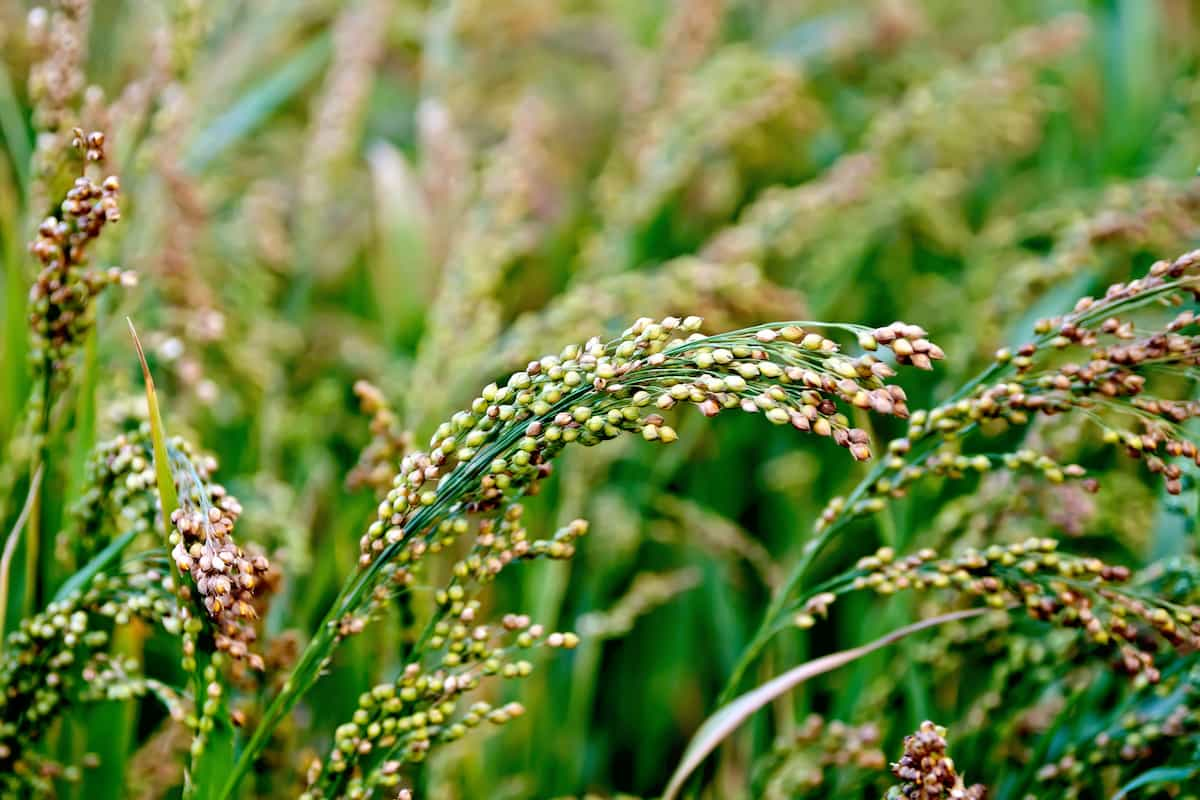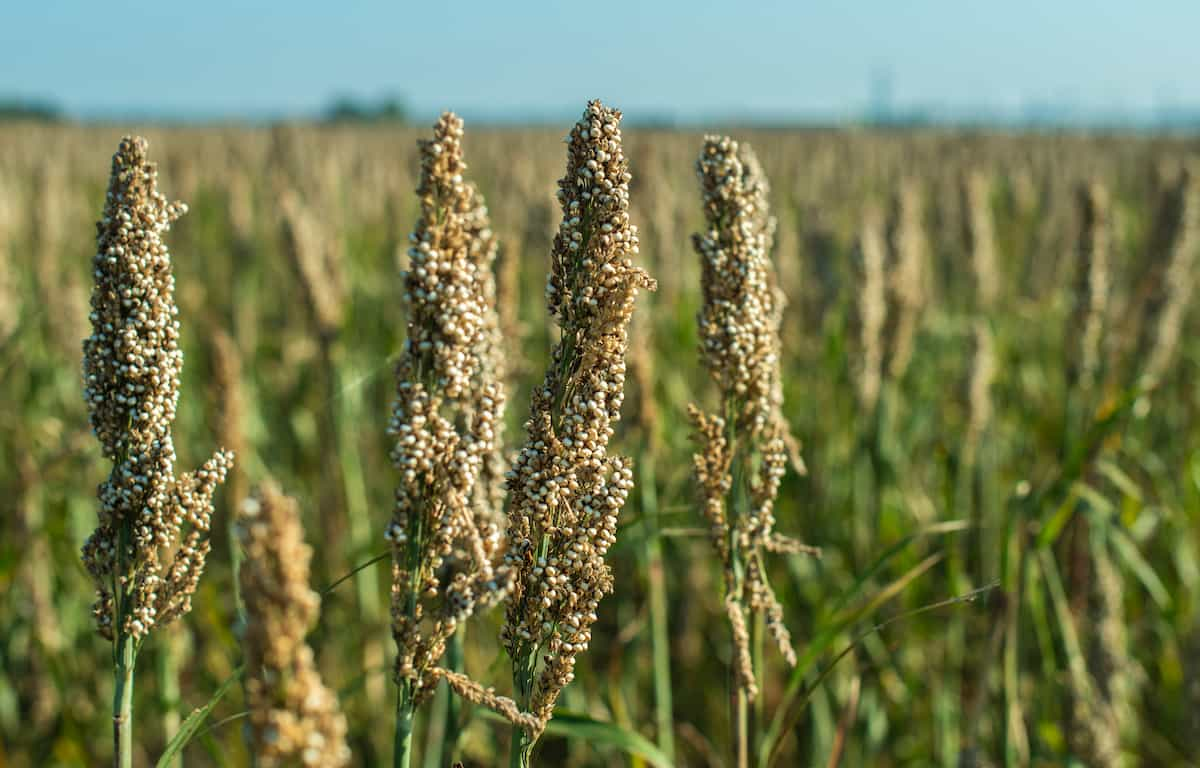A cereal crop, millets are members of the Poaceae family and resemble seeds. Grassy plants like this one have long stalks and are typically harvested for their edible seeds. Unlike most grains that grow best in cooler temperatures, millet prefers warmer weather, like rice and corn. More than 4,000 years ago, different millet varieties were grown in Asia and Africa.

While millet is primarily grown for its seed, many other reasons motivate people to grow it. Besides being an excellent cover crop, it is also good fodder for livestock and domesticated animals, and forage for livestock and grazing animals. It can also be mixed into the soil to add nutrients after harvest.
How to Grow Millets Organically
Types of Millets
Despite their similar taste, different millet types’ unique characteristics explain their popularity. Therefore, these millets are not comprehensive but highlight some of the most widely grown millets.
Proso Millet
The proso millet is the most popular millet in the US and is the only millet grown for food here. Its seeds come in various colors: white, cream, yellow, orange, red, black, and brown. Often referred to as the most adaptable millet, it is more tolerant of higher elevations than foxtail or pearl millet.
Foxtail Millet
Hay millet, Italian millet, or German millet are also named for foxtail millet. Originally from southeast Asia, foxtail millet is one of the oldest types of millet. Typically, it is the most economically valuable millet and the second most widely produced worldwide. The US typically grows foxtail as a catch crop for fodder and birdseed mixes, even though it is very popular in warm and temperate climates.
Pearl Millet
Africans primarily grow pearl millet as a food crop. Due to their ability to grow in poor, droughty, and infertile soil, they are important crops in less fertile agricultural regions in Africa and Southeast Asia. Pennisetum glaucum, however, is an adaptable crop that grows well in fertile soils with higher moisture levels. Light, well-drained, loamy, or sandy soils are ideal for pearl millet cultivation.
Finger Millet
Another type of millet grown in India and Africa is finger millet. In India, this crop is commonly referred to as Ragi. It is used for flour, bread, alcohol, and malt. As with pearl millet, this important crop is a good source of calcium and can be grown year-round in suitable climates.
Fonio
Fonio is a millet known as acha or hungry rice. With its growing popularity in West Africa, this millet thrives in desert conditions and is often grown on sandy or stony soils. There are two species of Fonio, white and black, with white being the most common. Among the millets, fonio is the smallest and requires the most labor to harvest.
Sun and Temperature Requirements for Growing Millets
There is no better place for millet than in the full sun. Choosing a place where ornamental millet will receive full sun will result in a beautiful deep purple color. Germination of this plant requires a warm temperature and is sensitive to frost. During the growing season, soil temperatures should reach 18.5°C since that is the minimum temperature for plants. Millet may not recover from temperatures between 4.5°C and 10°C, severely hampering its growth.
In case you missed it: How to Grow Snake Gourd from Seeds in Pots: A Step-By-Step Home Garden Guide for Beginners

Soil Requirements for Growing Millets
In the case of millet soil, less is more. In parts of Africa and Asia, farmers would plant millet when soil conditions were too poor to grow rice. The crop produces rather quickly, so growers could plant it three times a year in a suitable climate. Millet grows best in well-draining, warm, sandy, or loamy soils. A neutral pH range is optimal for its growth. The most important thing is to avoid planting millet in soil prone to waterlogging.
Sowing Millet Seeds and Growing
- If you want to plant millet, choose a plot that receives a lot of sunlight.
- Fertilize the soil with nitrogen-rich fertilizer before planting.
- Each seed should be planted at least 2 inches (5 centimeters) apart. Ensure the seeds are covered with at least one inch (2.5 centimeters) of soil. At least 12 inches (30.5 centimeters) should separate the rows of seeds.
- Compost or nitrogen-rich fertilizer can be added to the ground as the millet grows. Due to millet’s reliance on nitrogen, this is essential.
- Keep seedlings moist by mulching around them.
- Your millet does not need to be watered. The average rainfall should be sufficient for millet growth, so additional watering is unnecessary.
- It would be best if you harvested your millet when the grasses and seed heads have turned golden brown
Water and Humidity Requirements for Growing Millets
Due to its drought tolerance, millet does not require much water. Among all grain crops, Proso requires the least amount of water. Millets are shallow-rooted crops that absorb most of their water from the top three feet of the soil. It often receives most of its water from rainfall throughout the growing season.
This plant needs about one inch of water a week if you live where it doesn’t rain much. Before watering again, ensure the soil has begun to dry; millet does not grow well in waterlogged soil. For millet to dry off before night when temperatures drop, it is best to water with a drip system early in the day.
Organic Fertilizers Application in Millet Farming
Since millet is grown in less fertile soil, fertilizing is not necessary. When fertilizing millet, you should choose products with high nitrogen levels, such as feather meal. You should not apply fertilizer directly to the seed of this plant since it is susceptible to fertilizer burn. In addition to fertilizing at planting time, fertilizer should be applied four weeks later.
Organic Pest Control in Millets Farming
When growing millet, watch for grasshoppers, armyworms, chinch bugs, and false chinch bugs. Spinosad and neem oil are excellent treatments for fall armyworms. The liquid form of Bacillus thuringiensis, BT spray, can also be used to treat armyworms and grasshoppers. The pyrethrin, or a spray form of Beauvaria bassiana, a natural fungus that eliminates chinchillas, can be used to treat them.
In case you missed it: How to Grow Vegetables Organically: A Step-By-Step Guide for Beginners

Organic Disease Control in Millet Farming
A variety of diseases can affect millet, but none are extremely prevalent. Powdery mildew, bacterial blight, skin smut, and leaf spots such as Alternaria leaf spots are some to watch out for. Neem oil effectively treats powdery mildew, and copper fungicides can treat powdery mildew and leaf spots. In some cases, copper fungicides can be applied early to pre-treat smut and bacterial blight. Smut is fungal in origin so it may respond to early pre-treatment with copper fungicides.
Conclusion
Millet has a high level of climate resistance as a crop. As water and fertile soil will always be in short supply, it does not require much water or fertilizer. Due to its ability to thrive in harsh climates, it uses less water and costs less to produce than quinoa. This low-carbon option could help feed the growing population with less environmental impact than other popular cereal crops.
- Feed Your Flock for Less: Top 10 Tips to Save on Chicken Feed
- Ultimate Guide to Ossabaw Island Hog: Breeding, Raising, Diet, and Care
- Hatching Answers: The Top 10 Reasons Your Chickens Aren’t Laying Eggs
- Eggs and Economics: Breaking Down the Cost of Raising Backyard Chickens
- Defend Your Greens: Proven Methods to Keep Iguanas Out of Your Garden
- Ultimate Guide to Cinnamon Queen Chicken: A Comprehensive Guide for Beginners
- Ultimate Guide to California Tan Chicken: Breeding, Raising, Diet, Egg-Production and Care
- Ultimate Guide to Marsh Daisy Chicken: Breeding, Raising, Diet, and Care
- 10 Types of Chicken Farming Businesses You Can Start for Profits